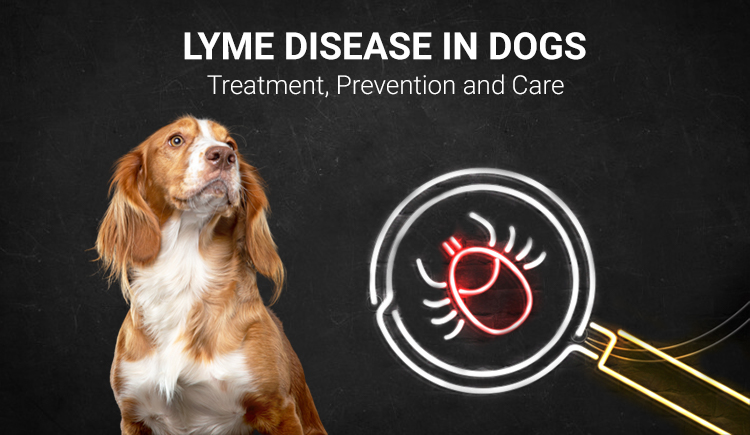Lyme disease has become more widespread in people, and as a result, many pet parents are concerned about the condition of their pets. While tick-borne illness is hazardous, it does not have to be fatal for our canine companions. Nonetheless, dog parents must remain cautious and responsible when it comes to preventing and treating Lyme disease in their pets. Here’s all you need to know about dog Lyme disease so you may be informed and prepared.
What causes Lyme disease in dogs?
Ticks, particularly the deer tick, contain the bacterium that causes Lyme disease in dogs, just as it does in people. According to several studies, ticks most likely to carry Lyme disease are located in forests and woods (particularly near cedar trees), marshes, tall grass, and dense brush. In terms of regional distribution, ticks carrying Lyme disease have been spreading across the United States in recent years, but are most common in the Northeast, upper Midwest, and Pacific Northwest.
These nasty little bugs can latch on and bite if your dog spends time in the woods, marshes, meadows, or bushy places without sufficient tick protection. Those bites can carry bacteria that cause Lyme disease into your dog’s blood circulation, and that’s when we have a serious concern.
How is Lyme disease tested in dogs?
A combination of history, physical signs, and tests are used to make a diagnosis. The C6 Test and Quant C6 Test are the two blood tests used to diagnose Lyme disease in dogs. Both are done by veterinarians.
Antibodies to a protein termed “C6” are detected using the C6 test. The presence of antibodies indicates that Lyme disease is active. C6 antibodies can be detectable in the bloodstream three to five weeks after a dog is bitten by an infected tick, and even before the dog shows indications of sickness.
The Quant C6 test is the next step. This, together with a urinalysis, will aid in determining whether antibiotic treatment is required. Because antibodies take time to appear in the blood after a dog is infected, testing dogs less than four weeks after a tick bite is not recommended.
What are the signs and symptoms of Lyme disease?
Dogs may not show symptoms for weeks or even months after being bitten by an infected tick and many dogs that are infected never show indications of sickness, stressing that Lyme disease symptoms vary depending on how far the infection has progressed. The following listed symptoms may occur:
- Fever
- Limping or lameness
- Loss of appetite
- Swollen joints
- Swollen lymph nodes
- Lethargy
- Stiffness
- Depression
- Excessive Salivating
- Problems with the kidneys (Kidney symptoms are less prevalent than other symptoms, but they’re also more harmful and can lead to kidney disease)
If you live in an area where ticks are common and your dog spends time outside, you should take them to the doctor as soon as possible if they exhibit any of these signs.
What is the treatment for Lyme disease?
Take a deep breath: Lyme illness in dogs is easily treatable if found early. Antibiotics are normally advised for at least 30 days. This usually relieves symptoms rapidly, although the infection may persist in certain cases, necessitating longer-term treatment. Other therapies focused on resolving or alleviating specific symptoms may also be used as part of the treatment. Antibiotic treatments for dogs may be required for extended periods of time or in more rounds at times. Your dog may also require therapy and treatments for certain organs or systems impacted by Lyme, such as the heart, nerves, joints, and kidneys, depending on how long they were unwell.
Read About- Best Treatments for Lyme Disease Prevention in Dogs
How to prevent Lyme disease in pets?
The best method to protect pets from Lyme disease is to adopt preventative measures to lower the risk of infection. Even in the waning days of summer, it’s vital to remember that tick-borne diseases like Lyme disease and Anaplasmosis, Ehrlichiosis, and Rocky Mountain Spotted Fever pose a larger danger to pets and people. Use effective tick-preventive products such as Nexgard, Bravecto, and Simparica Trio are known for reducing the risk of Lyme disease in dogs. Consult your veterinarian to determine which tick prevention product is best for your pet according to your pet’s health and your lifestyle.
Also, Read- WHICH ONE IS BETTER NEXGARD, SIMPARICA, REVOLUTION OR BRAVECTO? (A Detailed Comparison)
Bottom Line
Lyme disease in dogs can be cured if therapy or treatment is started earlier enough. That’s why, even if your dog doesn’t display any active symptoms, you should take them to the vet if you suspect they’ve been bitten by a tick. Lyme disease in dogs is a dangerous ailment, but as a pet parent, you have a lot of power to help your dog avoid it. Ticks don’t have to be so terrible if you take necessary precautions and treat your dog if he becomes sick. And you and your happy dog can have many more good days in the all the coming years!Visit BudgetPetWorld if you want to provide your dog with proper preventative care at an affordable price. Here you can find a variety of reliable tick-prevention products that significantly minimize Lyme disease transmission. Shop now and save on all of your pet’s preventive care and treatment

